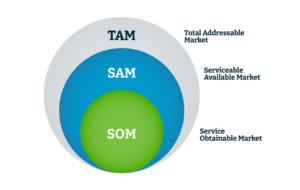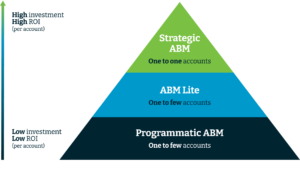No more silos
A MarketOne white paper written for web

Right Segment: Identify your target market and prioritize
Key levers:
- ICP, TAM,
- 1st and 3rd party intent

Ideal Customer Profile (ICP) is the customer who would most benefit from your product or service. It’s different from a buyer persona, which approaches the customer from a job title / role level. According to Gartner, the ICP “defines the firmographic, environmental and behavioral attributes of accounts that are expected to become a company’s most valuable customers”.
Total Addressable / Available Market (TAM) is everyone in the world who could buy your product or service if you had no competitors; it’s the potential scale of your market.
Serviceable Available Market (SAM) is a subset of TAM and the portion of the market within your geographical reach. For example, your service might only be in one language so is limited to countries speaking that language.
Service Obtainable Market (SOM) is a subset of SAM and is the portion of the market that can be realistically reached – it’s the one that matters the most.
Using ICP, TAM, SAM and SOM are a way to give campaigns and budgets laser-focus, particularly if you are selling a niche offering with an equally niche number of relevant customers.
Communicating the right message, to the right person at the right time, and delivering a Unified Buyer Experience, means you should be sure that this message is directed at the relevant audience, which starts at an account level. Identifying the organizations who would benefit most from your products and services is crucial.
The first step is the creation of an Ideal Customer Profile (ICP), which you can then use to build target account lists. Depending on available resources, you may go small and build only a small account segment, but the goal is to compile a definitive list of your complete account universe, your Total Addressable Market (TAM).
Using the ABM pyramid and segmenting
The need to scale has led to the emergence of three types of ABM

Once your account list is in place, you need to ‘slice and dice’ it; unless you are in an extremely niche market it will be too long to address, and different campaigns will inevitably target different segments.
The ABM pyramid is useful here to segment, tier and scale accounts. At the bottom, requiring low investment and ROI per account is programmatic ABM (one-to-many), ABM lite (one-to-few) in the middle, with strategic ABM (one-to-one) at the top. You may wish to engage one ABM approach or combine two or three.
Programmatic ABM can cover thousands of accounts grouped according to segments and, while not as focused as other ABM tiers, does utilize perhaps the limited resources you have to personalize and create buyer-centricity. ABM lite, or the one-to-few approach, focuses sales and marketing efforts on say 10 to 15 key target accounts. It is a personalized approach using tailored messaging but still has the potential to convert more than one-to-one AMB. Strategic AMB, or one-to-one, is a long-term strategy where teams target one to five high-value accounts to create deeply researched, hyper-targeted plans. This resource-intensive approach requires clients with business potential and a healthy budget.
Creating segments aligned with relevant criteria enables your sales and marketing teams to focus on driving business, but also facilitates faster feedback on the types of business most responsive to your products and services. How you segment might depend on the data you already own (first party) or that derived from external tools (third party), and you may also choose to refine your targeting further by customer journey stage.
A range of tools and techniques exist to help B2B businesses build account lists and segments but just as every campaign starts with the data, delivering a Unified Buyer Experience starts with unified internal communication. Regardless of the tools used, the key to success is ensuring that sales, marketing, operations, and even finance, are equally involved in every ‘pillar’, in particular with the definition of accounts and segments.
- 1. Crawl
- Start with a list of ‘lookalikes’ – businesses in your ICP that are like your existing clients. This requires relatively little investment and can often be managed by internal resources. Depending on existing or past sales and marketing activities, you may also have access to first-party data in the form of email subscribers or contacts acquired at events.
- 2. Walk
- Build out your full TAM, based on firmographic and technographic data. This can be further sub-segmented into SAM and SOM if required. Creating a TAM requires planning, research and access to tools or data sources to access technographic and firmographic information for many accounts.
- 3. Run
- Combine your lookalikes and TAM with first and third-party data, based on visitors to your website and external tools. Third-party intent data requires considerable investment but can help to identify accounts in your TAM that are potentially ‘in market’, enabling greater focus. Further tailor your communications by segmenting accounts based on their current customer journey stage.